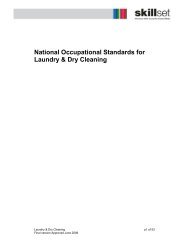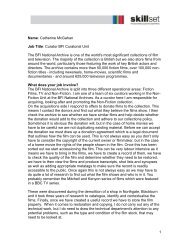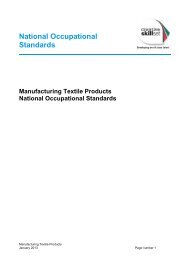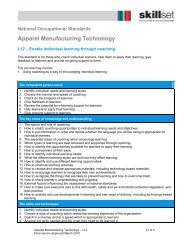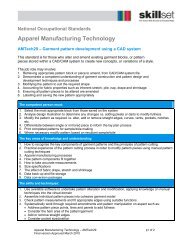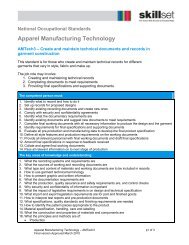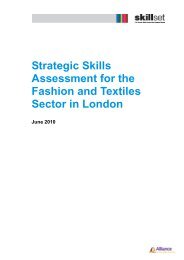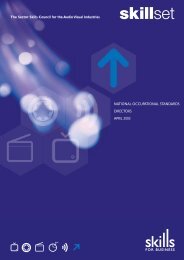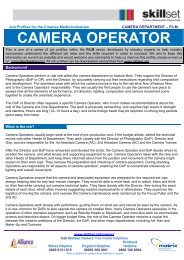CAREER PROFILE CLOTHING ALTERATION HAND - Skillset
CAREER PROFILE CLOTHING ALTERATION HAND - Skillset
CAREER PROFILE CLOTHING ALTERATION HAND - Skillset
Create successful ePaper yourself
Turn your PDF publications into a flip-book with our unique Google optimized e-Paper software.
Clothing alteration hands<br />
modify and repair items<br />
of clothing. They may use<br />
hand or machine sewing<br />
techniques and will have<br />
expert knowledge of<br />
garment construction.<br />
What does a clothing<br />
alteration hand do<br />
They may be involved in fastening<br />
new zips, taking in or letting out<br />
seams, shortening or lengthening<br />
hems and replacing trims. Clothing<br />
alteration hands may also work<br />
on specialist pieces, such as<br />
bridal gowns.<br />
The salary of a clothing<br />
alteration hand<br />
When starting out, a clothing<br />
alteration hand could expect to be<br />
paid around £11,000 a year with<br />
experience earning up to £16,000.<br />
Supervisors could earn £22,000<br />
a year or more.<br />
Hours and working environment<br />
Alteration hands usually work around<br />
40 hours a week. Saturday work<br />
is common for those employed in<br />
laundries and dry-cleaners.<br />
Part-time work and flexible hours<br />
are very common.<br />
A self-employed alteration hand<br />
may have a small, home-based<br />
workroom. Those based in a laundry<br />
or dry-cleaners may have a small<br />
workroom or working area within<br />
the store. Workrooms are usually<br />
warm and well-lit but can be small<br />
and cramped.<br />
Skills and interests<br />
To have a career as a clothing<br />
alteration hand, it is important to<br />
have good sewing skills. These can<br />
be obtained on a relevant course but<br />
on-the-job experience is also very<br />
valuable. The following skills and<br />
interests would also be useful:<br />
* an interest in fashion and a<br />
knowledge of tends and fabrics<br />
*<br />
*<br />
a focused approach to work with<br />
attention to detail<br />
to be self-motivated and able to<br />
work alone and to deadlines<br />
Entry into a career in<br />
clothing alteration<br />
Work-based learning qualifications<br />
such as apprenticeships or NVQs are<br />
a common way to get started as a<br />
clothing alteration hand and many<br />
companies will prefer candidates<br />
to have a relevant qualification.<br />
Check what options are available<br />
at your local college or visit<br />
www.abcawards.co.uk<br />
Further training to develop a<br />
career in clothing alteration<br />
Mastering different sewing<br />
techniques comes with experience.<br />
It can be useful to work alongside<br />
more experienced alteration hands<br />
to enhance practical knowledge.<br />
A wide range of short courses,<br />
qualifications and workshops in<br />
tailoring and garment production<br />
are also available from the<br />
London College of Fashion<br />
www.fashion.arts.ac.uk.<br />
Opportunities in the field of<br />
clothing alteration<br />
Opportunities for promotion may be<br />
limited, although supervisory posts<br />
may be available in larger companies<br />
to those with the relevant experience.<br />
Experienced alteration hands could<br />
become self-employed and may<br />
combine alteration work with design<br />
and craft roles. Strong business<br />
and marketing skills are useful for<br />
those who become self-employed.<br />
Experienced clothing alteration<br />
hands may also move into teaching.<br />
Case study<br />
Gail Sharlotte has<br />
worked at Johnson<br />
Apparelmaster for 20<br />
years as a clothing<br />
alteration hand and<br />
has always had a<br />
passion for sewing.<br />
When Gail started work,<br />
no formal qualifications<br />
were available in sewing<br />
so learned most of her<br />
skills on-the-job or at<br />
school. Gail says “Don’t be<br />
afraid to ask for help there<br />
will always be someone<br />
around to offer you tips<br />
and advice. You need to<br />
have a good eye for detail,<br />
have an understanding<br />
of garment construction<br />
and be conscientious as<br />
someone will have to wear<br />
the garment you are<br />
working on”.<br />
Gail’s work is varied as she<br />
may be repairing an arm<br />
sleeve one minute and<br />
attaching a new collar<br />
the next. Gail says “I love<br />
the work I do as it’s really<br />
varied and interesting<br />
with every garment<br />
requiring something<br />
different and I really look<br />
forward to coming to work.”<br />
For more information visit<br />
www.skillfast-uk.org/generationf



